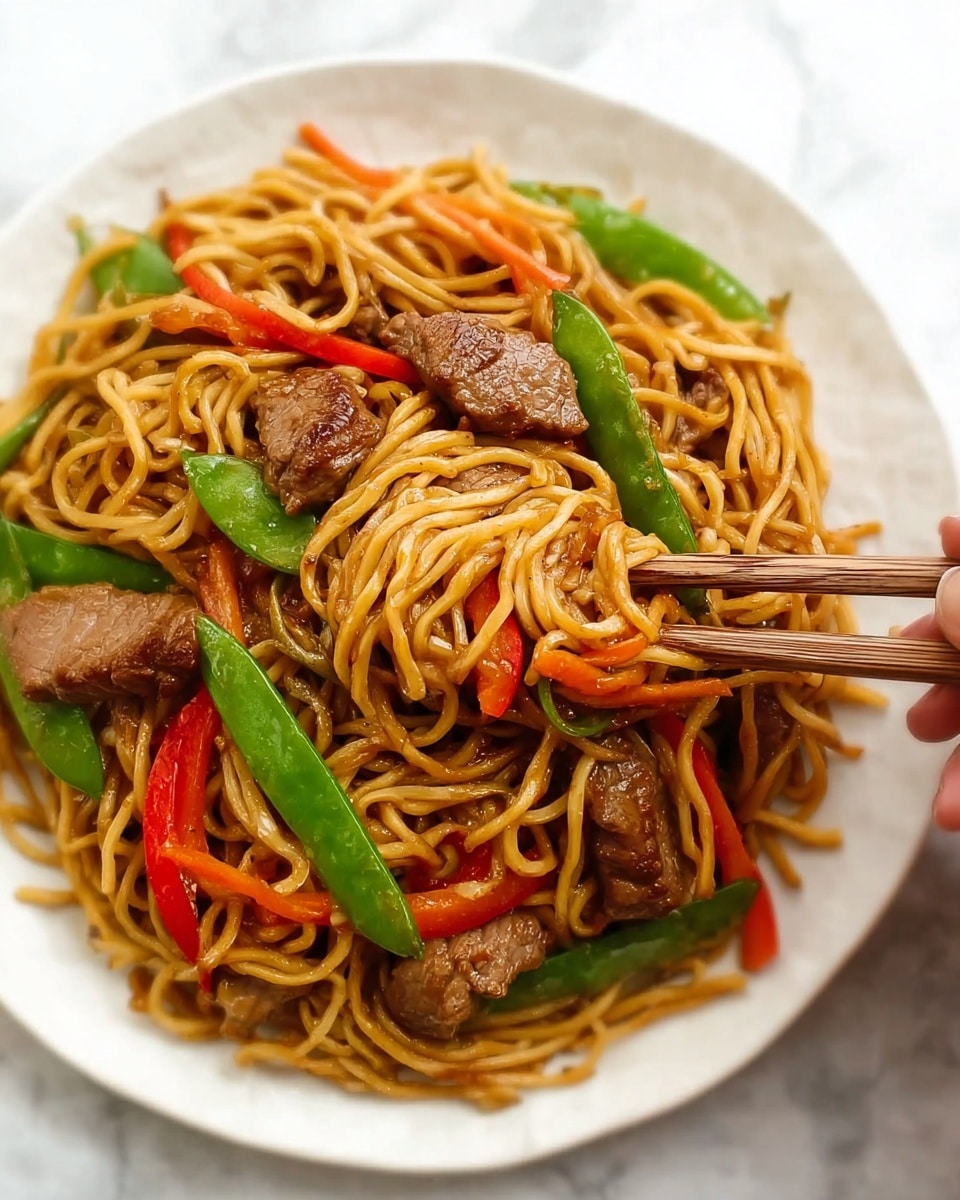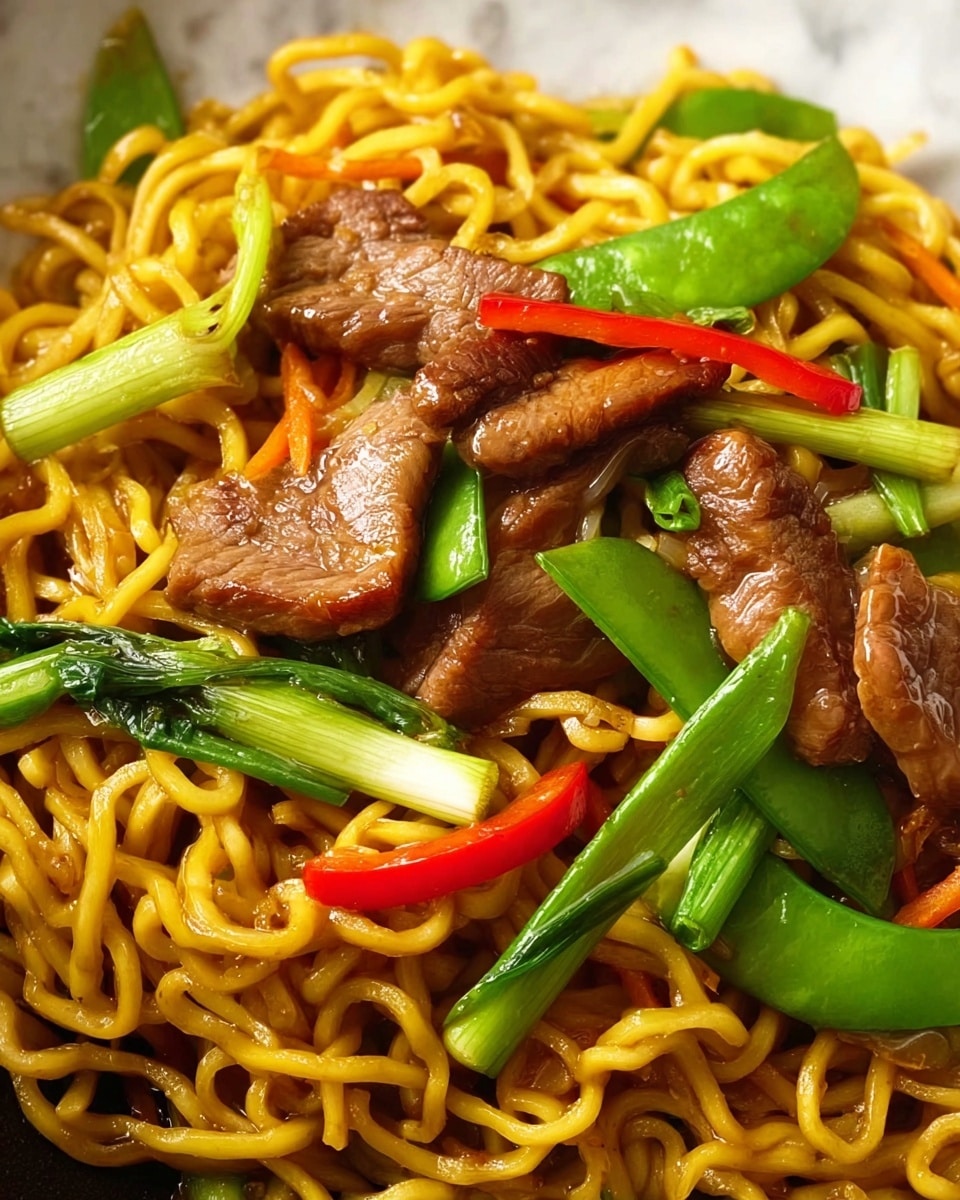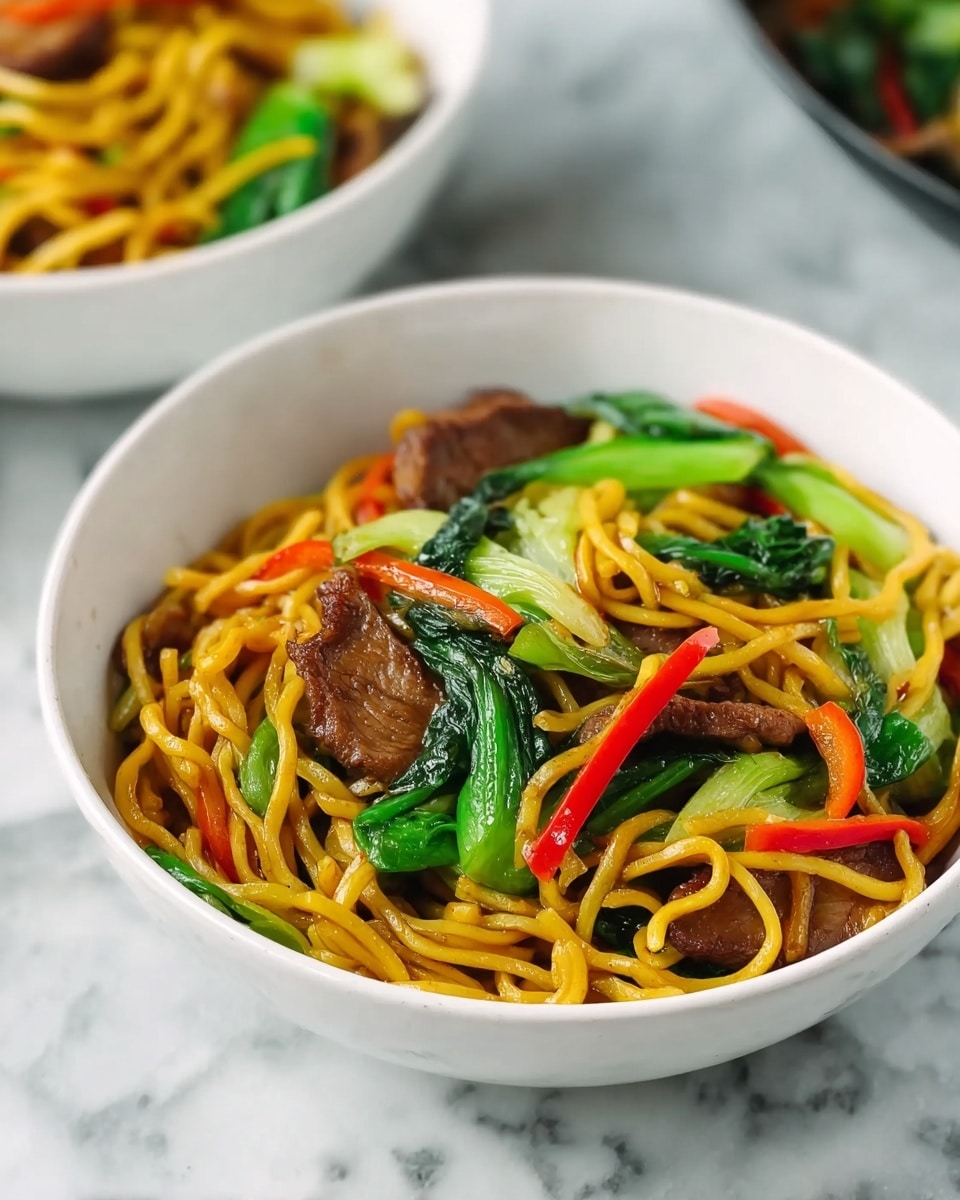If you’ve ever craved that delicious, comforting bowl of noodles packed with tender beef and crisp veggies, you’re in for a treat. This Beef Lo Mein Recipe is honestly one of my all-time favorites—it’s quick, flavorful, and hits all the right notes. Whether you’re cooking for a busy weeknight dinner or feeding friends who love bold Asian flavors, you’ll find this recipe really comes together fast and tastes like it’s been simmering all day.
Why You’ll Love This Recipe
- Super Quick to Make: You can whip up a restaurant-quality dinner in under 20 minutes, perfect for nights when time’s tight.
- Versatile Ingredients: The recipe works with a variety of beef cuts and noodle types, so no complicated shopping trips.
- Balanced Flavors & Textures: Tender beef, crunchy veggies, and saucy noodles create that perfect harmony every time.
- Family Approved: My family goes crazy for this one—it’s become a go-to for gatherings and regular dinners alike.
Ingredients You’ll Need
What I love about this Beef Lo Mein Recipe is how the ingredients effortlessly complement each other — the tender beef, fresh veggies, and that silky sauce. When you shop, it’s worth grabbing fresh lo mein noodles if you can, but egg noodles work well too.
- Fresh Lo Mein Noodles: Look for these in the fridge section of Asian markets, but any egg noodles will do if you can’t find fresh ones.
- Beef (sirloin, tenderloin, or rump): Choose tender cuts for the best texture, and slicing against the grain keeps the beef super tender.
- Mushrooms: Adds earthiness and a great bite; button or cremini work perfectly.
- Spring Onions: They bring freshness and a mild onion flavor—cut them into 2-inch pieces for texture.
- Bell Pepper: Julienned for a sweet crunch that brightens the dish.
- Cabbage Leaves: Thin slices add that subtle sweetness and crunch you want in lo mein.
- Snow Peas: Adds a crisp snap and fresh pop of green.
- Carrot: Julienned to blend nicely with the other veggies and lend some color.
- Vegetable Oil: For stir-frying—the neutral flavor lets the sauce shine.
- Sauce Mix (light soy sauce, sesame oil, dark soy sauce, oyster sauce, sugar, Shaoxing wine, white pepper): This combo is the magic behind that deep umami and slightly sweet glaze.
- Beef Marinade (sauce mix, cornstarch, baking soda): The baking soda is a little secret that tenderizes beef, making it juicy and soft.
Variations
This Beef Lo Mein Recipe is a great base for customization — I often change up the veggies depending on what’s in season or what’s in my fridge. Feel free to make it yours!
- Vegetarian Version: Swap beef for tofu or seitan, and use mushroom broth in the sauce instead of oyster sauce to keep that umami punch.
- Spicy Kick: I sometimes add chili flakes or a drizzle of chili oil—my family loves that extra heat!
- Low Carb Option: Try shirataki noodles or spiralized zucchini noodles to keep it lighter but still satisfying.
- Mixed Protein: Combine beef with shrimp or chicken for a surf-and-turf twist that’s impressive but still simple.
How to Make Beef Lo Mein Recipe
Step 1: Prepare Your Noodles and Sauce
Start by blanching your fresh lo mein noodles in hot water for just 1-2 minutes—don’t overdo it or they’ll get mushy later. Drizzle a bit of sesame oil and toss to keep them from sticking; this little trick also adds flavor. While the noodles rest, mix together the sauce ingredients in a small bowl—this is your flavor powerhouse, so don’t skip it!
Step 2: Prep the Beef and Veggies
Slice your beef thinly, cutting against the grain to ensure tenderness. Toss the beef with a tablespoon of the sauce mix, cornstarch, and baking soda—this marinade step is key for that melt-in-your-mouth texture. Meanwhile, wash and cut all your veggies: slice mushrooms, julienne bell pepper and carrot, chop cabbage leaves thinly, and cut snow peas and spring onions.
Step 3: Stir-Fry Everything With Love
Heat your wok or large pan over medium-high heat and add vegetable oil. Sear the beef slices by flattening them onto the pan, cooking 1-2 minutes per side until just browned—avoid overcooking here! Add your veggies next, starting with the hardest ones like carrots and cabbage, then mushrooms and peppers. Stir-fry veggies for 1-2 minutes so everything stays crisp and vibrant. Make a well in the center of your wok, add the noodles and pour in the sauce mix. Toss everything together thoroughly for 2-3 minutes until heated through and coated beautifully with sauce.
Step 4: Plate and Serve
Once everything’s hot and combined, remove from heat immediately to avoid soggy noodles. Transfer to serving plates and garnish with extra chopped spring onions and, if you like, a drizzle of chili oil for some punch. Serve right away and enjoy that perfect balance of tender beef, fresh veggies, and saucy noodles!
Pro Tips for Making Beef Lo Mein Recipe
- Marinate the Beef Properly: I discovered that adding baking soda to the marinade really tenderizes the meat, so don’t skip this step.
- Don’t Overcook Noodles: Blanch fresh noodles just briefly; they’ll finish cooking in the wok to stay perfectly chewy.
- Cook Veggies in Order: Start with harder veggies to ensure even cooking and maintain that satisfying crunch.
- Use High Heat and Fast Cooking: This technique seals in flavor and keeps the beef juicy rather than tough.
How to Serve Beef Lo Mein Recipe

Garnishes
My go-to garnish is extra chopped spring onions—they add a fresh, slightly sharp flavor right at the end. Sometimes I also like sprinkling some toasted sesame seeds for crunch and an extra nutty aroma. If you enjoy a little heat, a drizzle of chili oil or a few fresh chili slices bring the dish to life.
Side Dishes
I usually serve this beef lo mein alongside crunchy Asian pickles or steamed dumplings to complement the flavors. A light cucumber salad or a miso soup pairs beautifully as well—keeping the meal balanced but exciting.
Creative Ways to Present
For special occasions, I like presenting individual portions in warmed, shallow bowls with a sprig of cilantro or a lime wedge on the side. Another fun idea is serving the beef lo mein wrapped inside lettuce cups for a fresh, hands-on experience that everyone loves.
Make Ahead and Storage
Storing Leftovers
Leftover beef lo mein tastes great stored in an airtight container in the fridge for up to 3 days. I usually separate the noodles and sauce from the veggies if I have the time, so the veggies stay crisper when reheated.
Freezing
Freezing is doable but I don’t recommend it for best texture—noodles can get mushy after thawing. If you do freeze, spread the portions flat in freezer bags and consume within 1 month.
Reheating
To reheat, I find using a hot skillet with a splash of water or oil works best to revive the noodles and crisp up the veggies slightly. Avoid microwaving when possible to keep the texture intact.
FAQs
-
Can I use dry noodles instead of fresh lo mein noodles?
Absolutely! Dry egg noodles or even spaghetti noodles work in a pinch. Just follow the package instructions to cook them, but be careful not to overcook since they’ll stir-fry later.
-
What if I don’t have Shaoxing wine?
No worries! You can substitute Shaoxing wine with a splash of water or rice vinegar to keep the flavor balanced, especially if you prefer to avoid alcohol.
-
How do I make the beef more tender?
Marinate the beef with sauce mix, cornstarch, and baking soda for at least 10-15 minutes. The baking soda breaks down proteins and makes the meat incredibly tender when cooked quickly over high heat.
-
Can I add other vegetables to this Beef Lo Mein Recipe?
Definitely! Feel free to toss in broccoli, baby corn, bok choy, or snap peas—whatever you like or have on hand. Just adjust cooking times so vegetables stay crisp and bright.
Final Thoughts
This Beef Lo Mein Recipe has become a cornerstone in my kitchen because it’s just so reliable and tasty. I love how it allows me to sneak in a variety of veggies and pack in flavor without fuss. When I first tried it, I struggled to get that perfect beef texture, but once I learned the marinade trick, it was a total game changer. I’m confident you’ll enjoy making this as much as I do—so give it a go and savor every bite!
Print
Beef Lo Mein Recipe
- Prep Time: 10 minutes
- Cook Time: 10 minutes
- Total Time: 20 minutes
- Yield: 2 servings
- Category: Main Course
- Method: Stovetop
- Cuisine: Chinese
Description
This classic Beef Lo Mein recipe features tender slices of beef stir-fried with fresh vegetables and tossed with flavorful noodles in a savory Chinese-style sauce. Quick to prepare and packed with vibrant textures and umami, it’s a perfect weeknight meal that brings restaurant-quality flavors to your home kitchen.
Ingredients
Lo Mein Noodles
- 400 gram (14 oz) Fresh Lo Mein noodles or cooked egg noodles
Beef and Vegetables
- 250 gram (9 oz) Beef sirloin, tenderloin, rump, or any tender meat cut
- 3-4 Mushrooms, sliced
- 2-3 Spring onions, cut into 2″ pieces
- 1 Bell pepper, julienned
- 2-3 Cabbage leaves, thinly sliced
- 5-6 Snow peas
- 1 Small carrot, julienned
- 2 tbsp Vegetable oil
Sauce Mix
- 2 tbsp Light soy sauce
- 1 tbsp Sesame oil
- 2 tsp Dark soy sauce
- 4 tbsp Oyster sauce
- 1 tbsp Sugar
- 1 tbsp Shaoxing wine (or water or rice vinegar)
- ¼ tsp White pepper
Beef Marinade
- 1 tbsp Sauce mix
- 1 tsp Corn starch
- ¼ tsp Baking soda
Instructions
- Blanch Noodles: Blanch the fresh Lo Mein noodles in hot water for 1-2 minutes to soften. Drain and drizzle with a bit of sesame oil, mixing well to prevent sticking. Set aside.
- Prepare Sauce: In a small bowl, mix all the sauce ingredients including light soy sauce, sesame oil, dark soy sauce, oyster sauce, sugar, Shaoxing wine, and white pepper. Set aside.
- Prepare Vegetables and Beef: Wash and cut all vegetables into slices or julienne as appropriate. Slice the beef thinly against the grain for tenderness.
- Marinate Beef: In a bowl, marinate the beef slices with 1 tablespoon of the prepared sauce mix, corn starch, and baking soda. Let it rest for 10-15 minutes for the flavors to develop and meat to tenderize.
- Cook Beef: Heat a wok or large pan over medium-high heat. Add 2 tablespoons vegetable oil. Add the beef slices, flattening them out in the pan to sear. Cook for 1-2 minutes until browned, then stir-fry for another 1-2 minutes until almost cooked through.
- Stir-fry Vegetables: Add the vegetables starting with the hardest ones like carrots and bell peppers first. Stir-fry the vegetables with the beef for 1-2 minutes until they begin to soften but remain crisp.
- Add Noodles and Sauce: Create a space in the center of the wok. Add the blanched noodles and pour the sauce mixture over all the ingredients.
- Toss and Combine: Toss the beef, vegetables, noodles, and sauce together thoroughly, stir-frying for 2-3 minutes until everything is heated through and evenly coated with sauce.
- Serve: Remove from heat and transfer to a serving plate. Optionally, garnish with extra chopped spring onions and chili oil according to taste. Serve immediately and enjoy!
Notes
- Lo Mein Noodles: Fresh lo mein noodles can be found in most Chinese or Oriental grocery stores in the refrigerated section. They are also sometimes labeled as Hokkien noodles. You may also substitute with fresh, frozen, or dry egg noodles prepared as per package instructions before stir-frying.
- Shaoxing Wine: This is a traditional Chinese cooking rice wine that adds aroma and depth to the sauce. If you prefer not to use alcohol, substitute Shaoxing wine with water or rice vinegar for a non-alcoholic option.
Nutrition
- Serving Size: 1 serving
- Calories: 480
- Sugar: 6g
- Sodium: 1050mg
- Fat: 18g
- Saturated Fat: 3.5g
- Unsaturated Fat: 12g
- Trans Fat: 0g
- Carbohydrates: 52g
- Fiber: 4g
- Protein: 28g
- Cholesterol: 65mg




Your email address will not be published. Required fields are marked *